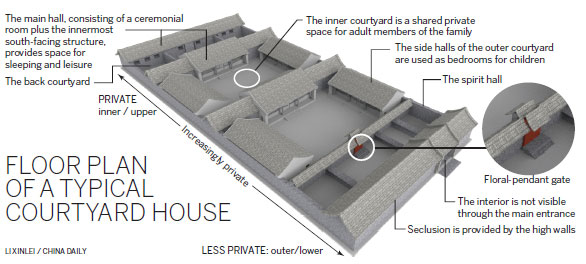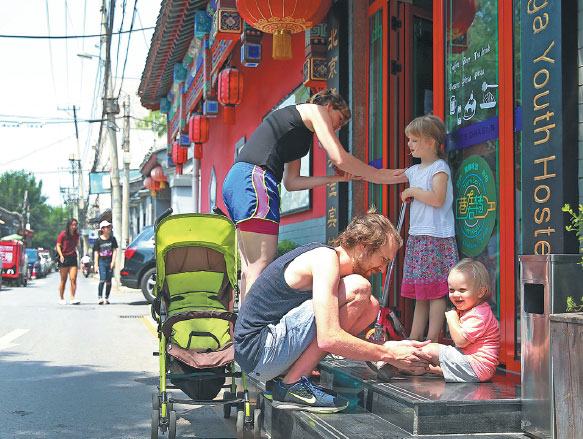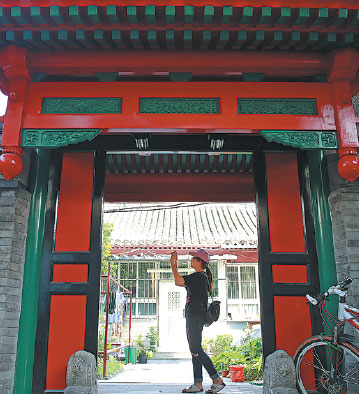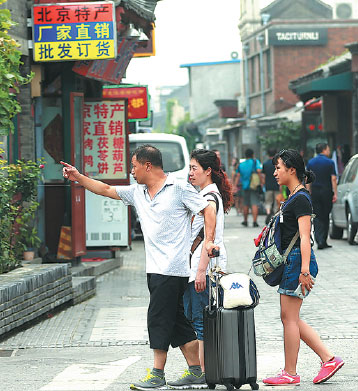Bringing new life to Beijing's ancient alleyways
The extensive network of interlocking streets is being refurbished to raise the residents' living standards and to capitalize on the capital's cultural 'golden name card'. Tang Yue and Cui Jia report.
For centuries, they provided homes for most of Beijing's residents, but for decades the capital's hutong, the maze of narrow, interconnected alleys that crisscrossed the city were deemed outdated and shabby, so they were torn down to make way for highly profitable real estate development.
In 1949, the year New China was founded, there were 3,073 hutong (the name is both plural and singular), but by 2005, the number had fallen by almost one-third to 1,353.
Now, although some are still being demolished - albeit at a much slower rate than before - the hutong are becoming increasingly recognized as cultural icons ripe for monetization.

In addition to the Forbidden City - the former residence of China's emperors - the collection of closely packed ground-level homes arranged in distinctive patterns, is now on the must-do lists of most visitors from home and abroad.
Some have become so popular with tourists that the residents find the attention overwhelming, and preservationists are concerned about the potential risk the crowds of visitors pose to the historic buildings.
The influx was so bad at Nanluoguxiang in the Dongcheng district, that in April the local government issued a ban on large tour groups entering the a 740-year-old hutong.
During a 2014 visit, President Xi Jinping said the alleys' rich historical and cultural legacy is the city's "golden name card" and urged a balance between preservation and development.
Now, the challenge for the local government, developers, urban planners and residents is to tell the story of these ancient alleys in a culturally and commercially sustainable way, instead of simply turning the "golden name card" into a gold mine.
Patience, inclusivity
Although Yangmeizhu Street is not the most popular hutong with tourists, it has been leading the way; not by speed, but by placing patience and inclusivity at the center of the process, factors not always seen in a fast-changing society.
Originally called Yangmei Street, and named after a female matchmaker, it was renamed Yangmeizhu Street - "the street of poplars, plums and bamboo" - early last century.
Despite its name, the 600-year-old hutong, located in the center of Beijing, about 500 meters southwest of Tian'anmen Square, has never been a botanical garden.
Instead, the 496-meter-long alley was once the home of Qingyunge, the city's most-popular shopping mall, and was the first place billiards was played in China. It has also been the home of many cultural figures, including the writer Shen Congwen (1902-88).
"You could meet a lot of famous men on the street back then. Sit down with any of the old people on the street and you will hear a lot of interesting stories that you can't read in any book," said Wang Xiuren, 63, a 21st-generation member of a family that has lived in Yangmeizhu for more than four centuries.

Until 1956, the Wang family ran a business that sold dogskin plasters, used to treat rheumatism, strains, cuts and bruises. The family's two yards were occupied by newcomers during the period of nationalization, and later the "cultural revolution" (1966-76). Not all of the property has been returned to the family yet.
In 1996, Wang, a former librarian, opened a bookshop in a house in the street, but business was poor because the old alley was losing its "old-time" glamour.
Ancient and modern
Wang first noticed the changes in the alley in 2011, when Beijing Design Week was introduced as part of the "Dashilan Organic Renewal Plan", which includes Yangmeizhu.
Unlike Nanluoguxiang, which is full of restaurants and souvenir shops, on Yangmeizhu, a bookshop stands next to an art gallery, while an independent design studio is the neighbor of a guitar store.
"On one hand, it seems to have regained its former glory with some modern elements. On the other, as a local resident, I'm so happy it's not turning into another Nanluoguxiang, which is so crowded and noisy," said Wang, who volunteers to relate the street's history whenever events are held there.
Yangmeizhu is a huge contrast to the Qianmen area, just a block away. It was once Beijing's busiest commercial area, but was torn down and rebuilt with ancient-style establishments. It reopened on the eve of the opening ceremony of the 2008 Beijing Olympics, and is now home to both traditional Chinese stores and international fashion brands.
"Large-scale demolition and inauthentic historic representations are mistakes that we have tried not to repeat," said Jia Rong, head of the renewal plan and vice-general manager of Dashilan-Liulichang Cultural Development Ltd, which works alongside the local government.
"Legally, it is not permitted to demolish buildings in the historic preservation zone and force the residents to move out. Financially, it would also be impossible to relocate so many residents simultaneously."
Instead, the company offers compensation or a housing exchange, which residents can accept any time they want.
So far, more than 600 households of the 1,700 residents have opted to leave, while the others, including Wang's family, have chosen to stay, Jia said.
The company rents some of the buildings to businesses whose concepts are compatible with the neighborhood, offering good deals to those likely to enhance the area's cultural appeal or enrich diversity but which may not be very profitable.
Three years ago, Li Kuo, from Taiwan, opened a design studio on the street. He compared the renovations with those on his home island.
"The upgrading of the old neighborhoods in Taiwan has a longer history, and from what I've seen, it can't be achieved in a very speedy fashion," he said. "It's really a great comfort to see that there are spaces available for less-profitable businesses in such an expensive area in fast-changing Beijing."
The problem is that some of the yards are half-empty or have few residents, so Jia and her colleagues have invited architects to redesign the yards and transform the empty houses into public spaces.
"In the long run, some residents will stay for good. We don't know the number yet, and we haven't set a target," Jia said. "After five years of experiments, our next step will be to better invigorate community life by the introduction of various establishments."
The 63-year-old Wang was happy to hear that. She organizes members of the alley's younger generation, most of whom live elsewhere, to help with the business when they are free - not to save money, but to ensure that the young people maintain a connection with their family roots.
"Ultimately, it's not only about the place, it's about the people who live here," she said.
Contact the writer at tangyue@chinadaily.com.cn
|
The rebuilt Shijia hutong attracts many tourists from around the world. Photos By Zou Hong / China Daily |
|
A repaired floral-pendant gate in Shijia hutong. |
|
Yangmeizhu Street, one of Beijing's oldest hutong, has become one of the most popular tourist spots in the capital. |
(China Daily 08/23/2016 page12)

















